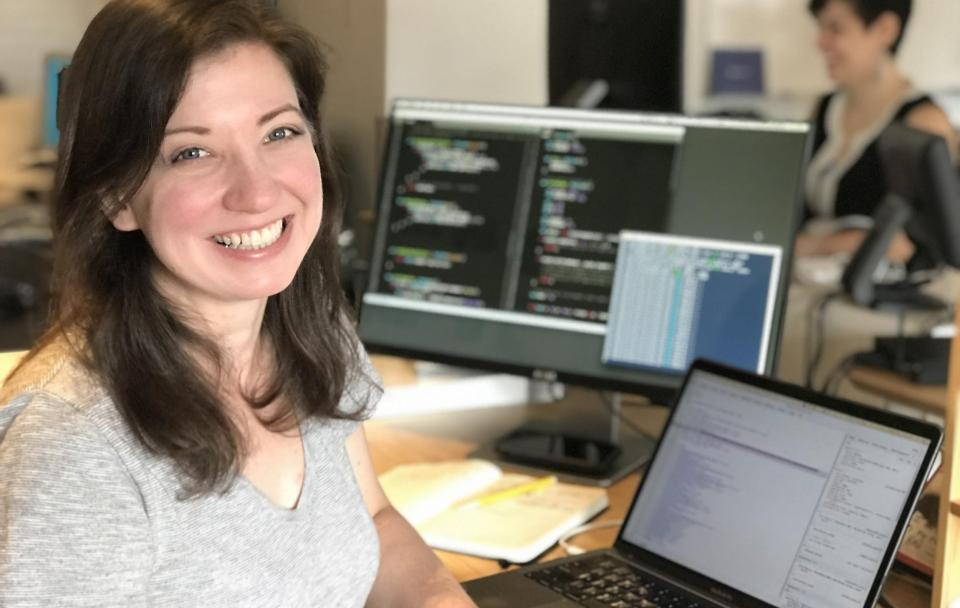University of the Arts Continuing Education alumna Christina Deemer sits at her desk at the former Interactive Mechanics, coffee in hand. “I’m going to show you a project we just completed for a large medical school,” she says.
A pattern of colorful interactive bubbles float from right to left on the screen and then change direction.
“It’s an interactive donor wall we created for them. What JavaScript is doing here is handling all the interactivity.”
Deemer spent 12 years in the nonprofit arts world before deciding that web design was for her. To kickstart her new career, she enrolled in a continuing education program in web design at UArts, and then apprenticed at Old City’s Interactive Mechanics, where she worked as a developer until it shut down in October.
JavaScript, created by Netscape’s Brendan Eich in 1995, is still one of the most ubiquitous languages on the web.
“I use JavaScript in every single project I build professionally — it’s a skill employers expect web developers to have,” Deemer says. “There is actually an axiom called ‘Atwood’s Law’ that any application that can be written in JavaScript will be written in JavaScript.”
Deemer’s alma mater is offering a brand-new front-end web development with JavaScript certificate program starting in Spring 2019. The program features a cohort model, where students work with a group throughout the program, have a flexible class schedule and learn from industry practitioners as instructors.
Learn moreThe program at UArts is aimed at those interested in moving into web design and development as well as those managing databases. David Chaplin-Loebell, an instructor and program advisor for UArts Continuing Education, adds that the JavaScript program will work well for students who want to “acquire the deeper technical skills required for developer roles, but also could be a launchpad for many other development careers.”
For Deemer, JavaScript proficiency is a skill she relies on daily in her new career.
“The great thing about JavaScript is that you can make it more complex,” she says, “so it’s not just about clicking on something and changing its color; I can create an algorithm so that each of these bubbles on the screen can animate on its own unique path.”
Deemer is appreciative of the knowledgeable instructors she had at UArts and the cohort model, which fostered “peer learning” and generally made the program a more enjoyable experience.
“We built friendships, we helped each other debug our programs,” she says. “To this day we will message each other with error messages we get.”
Learn more
This post is sponsored by University of the Arts and was reviewed prior to publication.
Before you go...
Please consider supporting Technical.ly to keep our independent journalism strong. Unlike most business-focused media outlets, we don’t have a paywall. Instead, we count on your personal and organizational support.
3 ways to support our work:- Contribute to the Journalism Fund. Charitable giving ensures our information remains free and accessible for residents to discover workforce programs and entrepreneurship pathways. This includes philanthropic grants and individual tax-deductible donations from readers like you.
- Use our Preferred Partners. Our directory of vetted providers offers high-quality recommendations for services our readers need, and each referral supports our journalism.
- Use our services. If you need entrepreneurs and tech leaders to buy your services, are seeking technologists to hire or want more professionals to know about your ecosystem, Technical.ly has the biggest and most engaged audience in the mid-Atlantic. We help companies tell their stories and answer big questions to meet and serve our community.
Join our growing Slack community
Join 5,000 tech professionals and entrepreneurs in our community Slack today!

The person charged in the UnitedHealthcare CEO shooting had a ton of tech connections

From rejection to innovation: How I built a tool to beat AI hiring algorithms at their own game

Where are the country’s most vibrant tech and startup communities?


